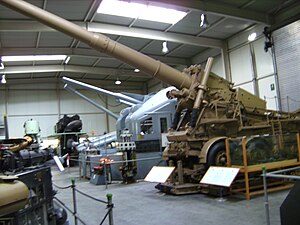| 24 cm Kanone 3 | |
|---|---|
 A K 3 in the Wehrtechnische Studiensammlung Koblenz | |
| Type | Heavy Siege Howitzer |
| Place of origin | Germany |
| Service history | |
| In service | 1939–45 |
| Used by | Nazi Germany |
| Wars | World War II |
| Production history | |
| Designer | Rheinmetall |
| Designed | 1935–38 |
| Manufacturer | Krupp |
| Produced | 1938–44 |
| No. built | 14+ |
| Specifications | |
| Mass | 54,866 kg (120,959 lb) |
| Barrel length | 13.102 m (40 ft) |
|
| |
| Shell weight | 151.4 kg (334 lb) (HE) |
| Caliber | 238 millimetres (9.4 in) |
| Breech | horizontal sliding block |
| Recoil | dual-recoil hydropneumatic |
| Carriage | box trail |
| Elevation | 0° to +56° |
| Traverse |
6° on carriage 360° on platform |
| Rate of fire | 1 rd per 4–5 min |
| Muzzle velocity | 970 m/s (3,182 ft/s) |
| Maximum firing range | 37 km (23 mi) |
The 24 cm Kanone 3 (24 cm K 3) was a German heavy siege gun used in the Second World War by the first battalion of Artillerie-Regiment 84. Four were in service when Germany invaded Poland, assigned to the first two batteries of I./AR 84.[1] In the Battle of France the battalion still only had four guns.[2] By Operation Barbarossa all three batteries were equipped with two guns apiece.[3] This situation did not change for the next two years.[4]
Design & History[]
The K 3's gun design was nothing innovative, but the same cannot be said for the carriage. Rheinmetall placed a lot of emphasis on ease of assembly. It did not require a crane because it used electric winches, mounted on the carriage, to pull various parts through a system of inclined ramps, guide rails and runways. It also used the Rheinmetall's dual-recoil system, first seen on the 21 cm Mörser 18. The barrel recoiled normally in its cradle, but, in addition, the whole top carriage, which carried the barrel and its cradle, recoiled across the main part of the carriage. This system damped out the recoil forces and made for a very steady firing platform.
The K 3 was a gigantic weapon that was transported in six loads. These consisted of the firing platform, the carriage, the cradle, the barrel, the breech and an electric generator.
The Wehrmacht was not content with the gun's performance: "It was felt to be wasteful of time and manpower, the transport arrangements were cumbersome and the performance was not considered to be commensurate with the size of weapon."[5] These led to experiments by Krupp and Rheinmetall to extend the range. These included "pre-grooved" projectiles which showed no significant improvement, squeeze-bore, discarding sabot and even a smoothbore version. None of these reached beyond the experimental stage.
Notes[]
- ↑ Niehorster, Leo W. G. German World War II Organizational Series, Vol. 1/III: Higher Headquarters - GHQ Units - Static Units (1.09.1939), 2004, p. 39
- ↑ Niehorster, Leo W. G. German World War II Organizational Series, Vol. 2/II: Mechanized GHQ units and Waffen-SS Formations (10 May 1940), 1990, p. 28
- ↑ Niehorster, Leo W. G. German World War II Organizational Series, Vol. 3/II: Mechanized GHQ units and Waffen-SS Formations (22nd June 1941), 1992, p. 27
- ↑ Niehorster, Leo W. G. German World War II Organizational Series, Vol. 4/II: Mechanized GHQ units and Waffen-SS Formations (28th June 1942), 2004, p. 25 and German World War II Organizational Series, Vol. 5/II: Mechanized GHQ units and Waffen-SS Formations (4 July 1943), 2005, p. 44
- ↑ Hogg, p. 104
References[]
- Engelmann, Joachim and Scheibert, Horst. Deutsche Artillerie 1934–1945: Eine Dokumentation in Text, Skizzen und Bildern: Ausrüstung, Gliederung, Ausbildung, Führung, Einsatz. Limburg/Lahn, Germany: C. A. Starke, 1974
- Gander, Terry and Chamberlain, Peter. Weapons of the Third Reich: An Encyclopedic Survey of All Small Arms, Artillery and Special Weapons of the German Land Forces 1939-1945. New York: Doubleday, 1979 ISBN 0-385-15090-3
- Hogg, Ian V. German Artillery of World War Two. 2nd corrected edition. Mechanicsville, PA: Stackpole Books, 1997 ISBN 1-85367-480-X
- Weapon Production Totals on Sinews of War
External links[]
| Wikimedia Commons has media related to 24 cm Kanone 3. |
| ||||||||||||||||||||||||||||||||
The original article can be found at 24 cm Kanone 3 and the edit history here.